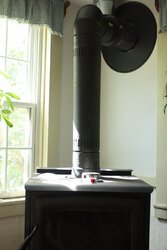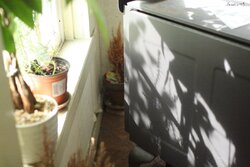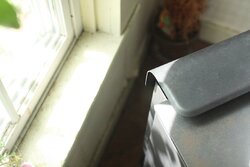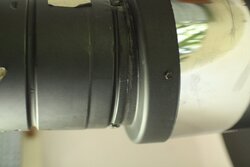Hi all,
Happy almost burning season to you!
A month ago, I disassembled the short stove pipe leading from my PE Summit to my wall piece to clean it out. I've done this once before, and I was able to get it reassembled (although it was a pain). This time, I've encountered snags. It's about 5' of pipe that has a couple of 45 degree turns and meets the pass through that is mounted though a wall.
First, if I was to line everything up the way the original installer did it, there are places where the pipes don't come together perfectly. For instance, where the pipe meets the pass through piece at the wall doesn't sit perfectly flush and flat on the fitting, leaving a hair-line opening at the joint that reveals the metal insert liner that runs through the connection. This makes me anxious.
It's possible, that smoke will not, and has not, exited through this small gap, given that there is a liner in there, but I would much rather have the pipes fit perfectly together.
It is my guess that the installer wrenched the pipes a bit out of alignment in order to reach the positioning of the stove.
Is this something that would bother you or cause you concern?
It's very likely, that these pipes have operated just fine in this very way for the last several years, with no appreciable ill affects.
Also, I have a devil of a time getting the pipes back together, since they are very hard to twist together, and to reposition. Does anyone know of a trick that the pros use to maneuver pipes around? Is there a tool that they use?
I had made an appointment with the local wood stove place to have an installer come over and just do the thing right, so I could take the thing apart to clean it again not have the same problem. But, they screwed up the appointment, and don't seem hugely psyched to come out and clean up someone else's mess. I'm sure there's minimal profit in there for them. I'm now thinking again about trying to reassemble the thing myself, perhaps just leaving the small gap there, and saving the coin.
So… Any thoughts as to how to bail myself out of this? Any help would be greatly appreciated!
Happy almost burning season to you!
A month ago, I disassembled the short stove pipe leading from my PE Summit to my wall piece to clean it out. I've done this once before, and I was able to get it reassembled (although it was a pain). This time, I've encountered snags. It's about 5' of pipe that has a couple of 45 degree turns and meets the pass through that is mounted though a wall.
First, if I was to line everything up the way the original installer did it, there are places where the pipes don't come together perfectly. For instance, where the pipe meets the pass through piece at the wall doesn't sit perfectly flush and flat on the fitting, leaving a hair-line opening at the joint that reveals the metal insert liner that runs through the connection. This makes me anxious.
It's possible, that smoke will not, and has not, exited through this small gap, given that there is a liner in there, but I would much rather have the pipes fit perfectly together.
It is my guess that the installer wrenched the pipes a bit out of alignment in order to reach the positioning of the stove.
Is this something that would bother you or cause you concern?
It's very likely, that these pipes have operated just fine in this very way for the last several years, with no appreciable ill affects.
Also, I have a devil of a time getting the pipes back together, since they are very hard to twist together, and to reposition. Does anyone know of a trick that the pros use to maneuver pipes around? Is there a tool that they use?
I had made an appointment with the local wood stove place to have an installer come over and just do the thing right, so I could take the thing apart to clean it again not have the same problem. But, they screwed up the appointment, and don't seem hugely psyched to come out and clean up someone else's mess. I'm sure there's minimal profit in there for them. I'm now thinking again about trying to reassemble the thing myself, perhaps just leaving the small gap there, and saving the coin.
So… Any thoughts as to how to bail myself out of this? Any help would be greatly appreciated!





